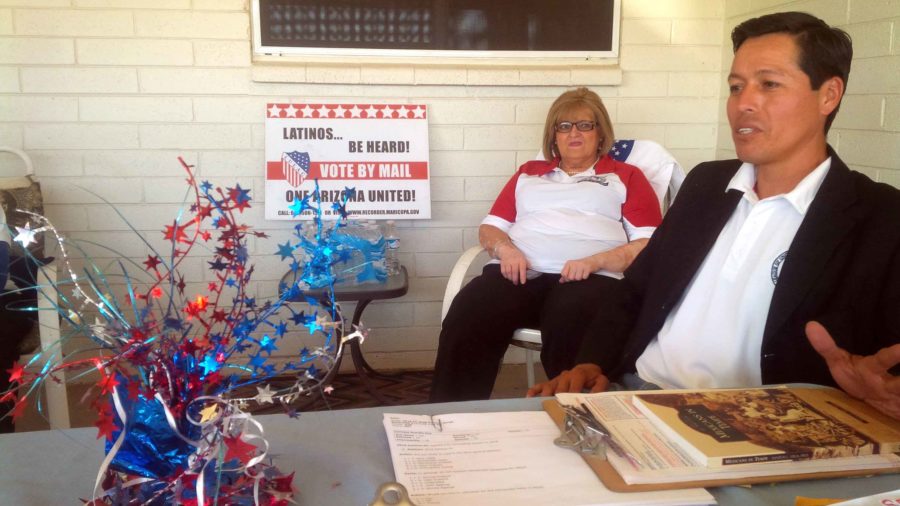Why the election map has a built-in, and growing, Democratic bias
Volunteers Ana Valenzuela Estrada and Richard Estrada, no relation, in Glendale, Ariz., belong to one of several groups aiming to register 3 million new Latino voters across the nation by November. (Seema Mehta/Los Angeles Times/TNS)
September 12, 2016
WASHINGTON — The presidential election map is undergoing a fundamental change, with shifts that will make it easier for Democrats to win not only in 2016 but also for years to come.
Driving the change are two demographic trends: The share of Hispanic and under-30 voters, who favor Democrats in big numbers, is growing significantly in states that in the last decade were decent bets to vote Republican.
“We’re moving in a direction where the demographic map makes it harder and harder for Republican candidates to win the presidency if current conditions continue,” said Mark Hugo Lopez, the director of Hispanic research at the nonpartisan Pew Research Center.
Advertisement
Colorado, Nevada and Pennsylvania illustrate how the demographic changes are giving Hillary Clinton an electoral advantage Democrats are unlikely to lose anytime soon. Clinton leads in Pennsylvania and Colorado, which for years were regarded as swing states, and she has a polling edge in Nevada.
Already moving toward the Democrats in the Obama era, Hispanics and younger voters are trending strongly Democratic in the Trump era.
Since 2006, when a bloc of congressional Republicans began vocally urging a crackdown on immigrants who are in the U.S. illegally, “Republicans seem to be their own worst enemies,” said Clarissa Martinez de Castro, deputy vice president of National Council of La Raza, a nonpartisan group that studies Latino issues.
Seventy percent of Latinos said Republican nominee Donald Trump had made the GOP more hostile to Hispanics, according to a poll of Hispanic voters last month by Latino Decisions. Trump was viewed unfavorably by 3 out of 4 Hispanic voters, a late August Latino Decisions poll found. Clinton trounced Trump with Latinos, 70-19 percent.
That’s notably damaging to Republican presidential prospects in states where the Latino vote is growing, particularly Colorado and Nevada.
Each has seen a boom in Hispanic voters in recent years, and both states were easy victories for President Barack Obama in 2008 and 2012. In 2000 and 2004, George W. Bush, who had strong ties to the Latino community, won both states.
Latinos made up 8 percent of the Colorado electorate and 10 percent of the Nevada total in 2004. This year, 15 percent of eligible Colorado voters and 17 percent of eligible Nevada voters are Hispanic.
Advertisement*
Clearly, “Trump has helped activate the Colorado Hispanic community,” said Floyd Ciruli, a Denver-based political consultant.
Clinton has opened a comfortable lead this year in Colorado, as an NBC News/Wall Street Journal/Marist College poll last month found her up 62-25 with Latinos in the state. In Nevada, a CBS News/YouGov August survey showed Clinton up 58-20 with Hispanics. Overall, Marist has Clinton up by 14 percentage points in Colorado and CBS/YouGov had her ahead by 2 in Nevada.
Republicans insist the party is making strides. They point to a strengthened ground game in Latino communities. They cite the electoral success of Gov. Brian Sandoval of Nevada, who is Mexican-American, and Gov. Susana Martinez of New Mexico, the nation’s first female Hispanic governor. Both were elected to second terms overwhelmingly in 2014. In Texas, Gov. Greg Abbott won an estimated 44 percent of the Latino vote that year.
Republicans, though, face another demographic challenge: The trend toward younger voters siding heavily with Democrats is also helping to push Colorado and Nevada, as well as Pennsylvania, solidly into Democratic hands.
Two key reasons: Republicans have not been in line with young voters’ thinking on social issues; younger people tend to strongly favor permitting same-sex marriage. And under-30 voters tend to include a larger proportion of racial minorities than the older population, minorities that tend to vote heavily Democratic.
In Pennsylvania, for instance, 13.8 percent of the state’s under-30 voters are African-American, up from 11.7 percent four years ago.
Also helping to boost young-voter turnout: Online registration is available for the first time this year. Younger voters tend to split over how they register, with half doing so online and half the traditional way, while older voters are less prone to register online. Those over 65 prefer paper registration by 6-to-1 over using the online feature.
The makeup of the younger population also has the potential to help Democrats in Ohio. About one-fourth of the state’s voters under 30 are married and a similar percentage have children. As a result, said an analysis from CIRCLE, which studies youth voting, many younger Ohio voters will look closely at candidate views on health care, early childhood education and the minimum wage. Emerson found Clinton up 18 points among younger voters in Ohio.
This election could be the start of one more demographic trend: white voters with college degrees leaning Democratic. For decades, they’ve favored Republicans — Romney won this group by 14 points — but Clinton’s up 11.
Ruy Teixeira, a co-author of a report by Washington research center scholars on changing election trends this year, found an “ongoing shift of white-collar, educated voters to Democrats.”
Clinton does particularly well with college-educated white women, said Doug Usher, managing partner at Purple Insights, an Alexandria, Va.-based polling firm that conducted the college-educated voters survey. That’s because so much of what Trump has said is “at odds with the political and cultural direction” that electorate wants to go.
Whether it’s a longer-term trend, though, is impossible to say. “The short-term answer is it’s a Trump thing,” Usher said.
___
(c)2016 McClatchy Washington Bureau
Visit the McClatchy Washington Bureau at www.mcclatchydc.com
Distributed by Tribune Content Agency, LLC.
Advertisement









